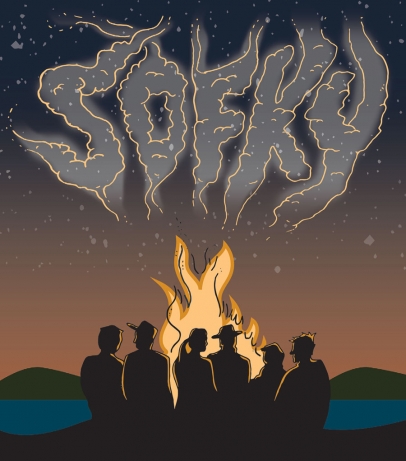The Lyes We Told
Traditional Creek sofky still nourishes today
“As long as the Indian can eat and drink osafki, he will not go dead.”
—Creek saying
The 15-year reunion of the Holdenville High class of ’98 convened at Baptist Point on Holdenville City Lake, near an empty picnic pavilion that offered a rusted charcoal grill on one end and a bird’s-eye view of a tall white cross thrust into a nearby patch of grass. A “No Swimming” sign had been posted but largely ignored and recent rains had brought the lake back to respectable levels. A boat pulling a skier made lazy, guttural wakes under a fading sun.
Of the near 80 who graduated, a hearty nine had gathered. They sat in lawn chairs and waited for no-shows, trading remembrances of things past. Small-town reunions are nearly a contradiction in terms. Those who leave town tend never to return. Those who remain see each other all the time, in the Walmart, or in the convenience stores buying smokes and big sodas and pumping gas. They are united, if not quite reunited. In their ranks, an outsider can participate as much or little as he feels fit. No different than a mosquito that wanders into their midst and decides which to avoid and which to bleed.
As the day turned twilight, two highschool football coaches appeared, tenured legends of Indian-summer fields. Their bellies bore their fondness for lager by the case. They told tall tales under the shadow-throwing lamplight. One began an almost-improbable debate on the gluten- friendly contents of cheap beer that would not end until it finally did, inevitably, in a change of subject.
“What did they use to eat then?” said a former linebacker.
“When?” said the coach.
“Way back.”
“Same as now. Sandwiches.”
“No, before.”
“What before?”
On a folding table near the pavilion, just-grilled sausages and wieners warmed under a tent of foil. Bags of chips, sandwich cookies, the occasional mystery dish. I ate a sausage that felt cool and uncooked in my mouth and took another drink of wine, hoping to drown any microbial hangers- on. Out on the lake, the water lapped at the bank like a dog at a bowl. Overhead, the stars frosted the night sky.
We had our fill, there and at another campsite in a nearby cove, and headed back down Broadway for home. Earlier, we’d made a pact to get the sofky going, no matter the hour. At one side or the other of 3am, I thumbed the spigot on the bottle of filtered water and filled the CrockPot. He, the Creek, poured the flint corn into the pot where it floated then drowned. We turned the dial to low and, the party over, turned out the lights.
Sofky being as much a process as a food, here is a recipe, from “American Indian Corn Dishes,” a history by Muriel H. Wright published in the Chronicles of Oklahoma:
Sofky (correct form “osafki”—Hominy): Shell good, clean and dried flint corn from the cob, enough to have a peck or more of the shelled grain to prepare sofky for several meals. Cover the shelled corn with cool water, and soak over night. Pound the soaked corn, or a portion, lightly in a wooden mortar enough to break the grains in half. Place the pounded corn in a fanner, and clean out the hulls. Put the clean, broken grain into a large vessel, cover with water and boil until thoroughly done. Add water if necessary from time to time to keep the hominy in a loose fluid. When it is cooked thoroughly, add ashlye solution in the proportion of a cupful to a gallon of the boiling hominy, stirring it regularly for it will scorch easily. Boil the hominy with the ash-lye solution for at least another half hour, then pour it into a stone jar to keep and serve.
Jimmy Deatherage, a retired oilfield worker and devotee of Middle Creek Baptist #1 near Seminole, buys his pearl hominy in Shawnee and, on Sundays, distributes his own handmade lye in the parking lot after services. “It’s the sofky man!” the sisters and brothers will say, except in spring, when he’s the wild onion man. He even has a card proclaiming it. In spring, the Creeks host a wild onion festival in Okmulgee. But it wasn’t spring.
“The lye,” he started to tell me. “Are you Seminole or white or what? There’s lots of Creeks up there around Tulsa.”
The lye, he told me, softens the corn and gives it a flavor, turns it a yellowish color. The Creek for ashes is “kvpe.” Sofky, or “kvpecvfke,” means “lye-drip.”
“Ashes of burnt wood,” said Deatherage. “We use green post oak or blackjack. Burn it all up. Clean, no kind of chemicals. A match and a little bit of kindling. Once you get the ashes all burnt, I take a five-gallon bucket and put small nail holes in the bottom. Put in three to four gallons of ashes. Pour hot water in with the ashes, about three gallons. It’ll filter through. Liquid comes out most of the time kind of like an apple juice color. Sometimes like weak tea. I’ve seen it come out real dark, when you burn straight blackjack wood.
“It took me several times to get it just right.”
There is a science to the lye, which Betty Fussell explains in The Story of Corn:
“The skins were managed one of two ways, by winnowing or by cooking. Lye hominy is the cooking of flint corn with wood ash or another alkali. Proteins essential to human diet are built on amino acids, one of which is niacin. Corn lacks niacin, but corn cooked in alkali—like slaked lime—unlocks the niacin. Beans became part of the diet because, taken with corn, the corn would not require the lime, beans being protein-rich.
“The Aztecs called it nixtamilization. The Anasazi of the American West practiced the same culinary art.”
My mother bought the art pre-canned and served it alongside pork chops. “Rockahomonie and sagamite to the Algonquian, atole to the Mexica, sofki to the Creek, tanlubo and tafala to the Choctaw— all hominy, primarily from late-harvest, thickskinned flint corns. Cooked it up into thick gruels, pottages, puddings called frumenty, loblolly and hasty pudding.”
The corn softens in the pot and swells in volume, as it did in Joel and Ethan Coen’s take on the Charles Portis classic True Grit. Sofky, in a smoky cabin of outlaws, symbolizing secrets:
Rooster:
“This here’s an awful lot of sofky. Was you boys looking for company?”
Quincy:
“That is our supper and breakfast both. I like a big breakfast.”
Moon:
“Sofky always cooks up bigger than you think.”
I woke in the morning to the chill of a window unit blowing overhead, and to the sour aroma of sofky. “What’s that smell?” the Creek’s daughter asked. It was our breakfast. We ate it straight, in Styrofoam cups with plastic spoons, then with salt, then with brown sugar. Nothing could sharpen its flavor, unremarkable yet steadying. A few shreds of deer jerky would have done wonders.
“Most Indians eat it bland straight off the stove,” Deatherage confirmed. “Some will leave it out and let it get sour. I don’t like that.”
“They’ll eat from it all day,” said my Creek host. “It’s a cheap way to stay full.”
That said, sofky’s role as a sustaining force has been muted by the encroachment of cheap and easy fast food. “Like a lot of other things,” Deatherage said, “not everybody cooks it. Not too many people that make the kvpe!”
Deatherage doles out lye from his trunk, but in the sanctuary at Middle Creek, the holy bread, baked on church grounds, is an unleavened tortilla made of flour. “The way we do communion,” he said, “is more spiritual than white people.”
So maybe it’s not the late-harvest corn and its lyes handed down, and maybe it’s not the post oak and blackjack and ash and the way it sours that Jimmy doesn’t like but knows some who do. Which means maybe it’s the communion.
“It’s not an everyday deal for me,” he said. “About every church meeting.”
Mark Brown is the author of My Mother is a Chicken (This Land Press, 2012).





